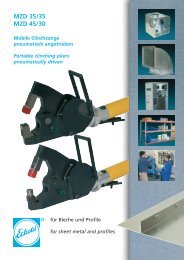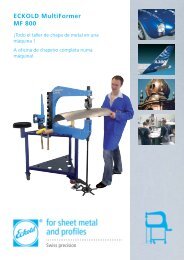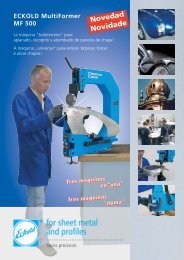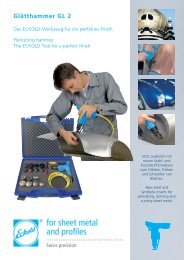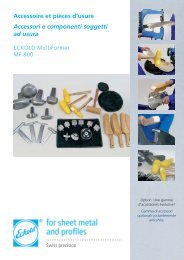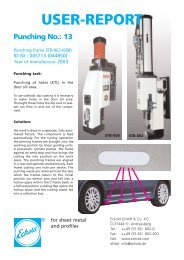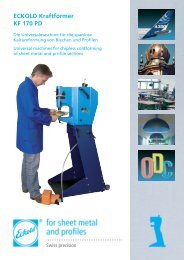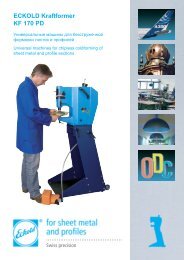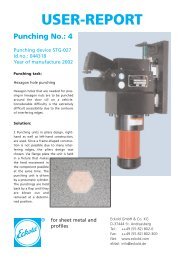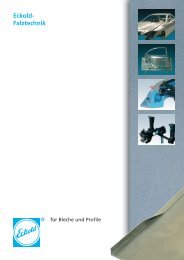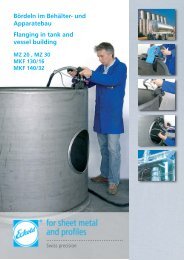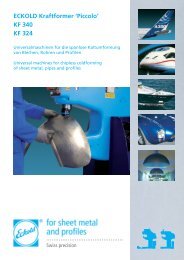ECKOLD AG
ECKOLD AG
ECKOLD AG
Create successful ePaper yourself
Turn your PDF publications into a flip-book with our unique Google optimized e-Paper software.
<strong>ECKOLD</strong> <strong>AG</strong><br />
Correcting and adjusting of sheet metal parts by shrinking and stretching<br />
Summary<br />
Shrinking and stretching are indispensable operations in aircraft manufacturing, mainly for<br />
correcting and adjusting of pressed parts of all sorts. The special machines and tooling of Eckold<br />
offer a highly efficient solution to assure precise fitting together of the individual parts.<br />
When young Walter Eckold (1895-1963) joined Junkers Aircraft Co. in Dessau/Germany in 1917 as a toolmaker he<br />
soon got involved in Professor Junkers' project to build metal aircrafts instead of those made out of wood. The<br />
forming of corrugated metal sheet the hard way, the bending of profile sections, or the blind riveting from one side<br />
only, those were the challenges in the newly formed department for jigs and fixtures.<br />
The shrinking of sheet metal turned out to be more complex to solve. How to remove too much material and to<br />
bring back the part into the desired shape, and all this by cold forming? The German patent no DRP 477 153<br />
granted in 1924 is describing the first shrinking machine. The two-levers hand pliers followed soon after permitting<br />
shrinking operations inside the structural body of the aircraft. These hand pliers were widely used in the aircraft<br />
industry.<br />
Walter Eckold left Junkers in 1936 and founded his own manufacturing company for jigs and fixtures for aircraft<br />
manufacturing. However, the metal forming and particularly the shrinking and stretching remained unsatisfactory as<br />
there was no universal equipment available yet. The break-trough happened 1950 when Walter Eckold introduced<br />
the first universal cold forming machine type KF 400.<br />
Today there is a full range of machines in different sizes called Kraftformer, having different throat depth and<br />
forming capacity. Maximum horizontal throat depth is 675 mm and a forming capacity of 6 mm thick steel, and 7<br />
mm of aluminium, reached with the largest machine KF665. This machine offers a large working area and allows to<br />
produce larger pieces too.<br />
Largest type of Eckold forming<br />
machine, KF665 with 675 mm<br />
horizontal space (Bilder: Eckold)<br />
Article for Aircraft Magazine<br />
The large selection of tools allows to find a solution for numerous forming and<br />
correcting jobs. Besides shrinking and stretching, there are tools for flattening,<br />
doming, and planishing, straightening and finish forming, all of them available<br />
in different sizes with different maximum forming capacities.<br />
Tool change is done in<br />
seconds which makes<br />
the use of the machine<br />
highly flexible. Machines<br />
and tools are designed<br />
to reach their maximum<br />
capacities without<br />
special effort and to do<br />
quick and efficient<br />
forming of profiles and<br />
other sorts of sheet<br />
CH-7203 Trimmis, Schweiz/Suisse/Switzerland<br />
metal. But, often more important in aeronautics, the system of tool and<br />
machine is designed to control the force applied extremely sensitively, which<br />
allows then to do very small and precise correcting and adjusting of pressed<br />
parts. For instance, the big machine KF 665 can operate with a maximum<br />
force of 700 KN, but is also able to work in a very smooth way on small and thin parts with just little force. A special<br />
series for tools is available for the aeronautical industry, which do shrinking and stretching with a high tech<br />
synthetical surface. This allows to treat the surface of the work piece according to the high quality requirements in<br />
the aircraft industry, basically without marks and without making scratches on the surface. The principle of the<br />
shrinking and stretching tools works in the way that the<br />
vertically applied force of the machine clamps the metal<br />
sheet in between the jaws of the tools. Additionally, part of<br />
the vertical force is transformed inside the tool to a<br />
horizontal one. In case of shrinking, the material is being<br />
upset, which results in increasing thickness of the material<br />
and a reduced (shrunk) surface of the piece. With<br />
Principle of Shrinking Principle of Stretching<br />
Large selection of tools for<br />
various forming operations<br />
stretching tools, the contrary happens, resulting in a<br />
thinner piece and an increased surface.
Generations of aircrafts have been produced with the help of Eckold<br />
shrinking and stretching machines, in the civil sector as well as in the<br />
military field (examples: A400M, Eurofighter). As well in helicopter<br />
manufacturing (for example EUROCOPTER), space flight and space travel<br />
(for example HERMES space plane, or the European Ariane carrier<br />
rocket), aircraft maintenance and repair shops, shrinking and stretching is<br />
used. The main task of the Kraftformer machines is to do correcting and<br />
adjusting of pressed parts. This means to correct the shape and<br />
dimensions of the part, to remove buckles or dents. For instance, this is<br />
being used for manufacturing of all the types of Airbus aircrafts in the<br />
factories of EADS in Germany, France and Great Britain as well in<br />
numerous parts supplying companies to Airbus.<br />
Correcting Job with Eckold forming machine KF460 of a lower covering part of of<br />
the floor section for the Aribus A380<br />
Correcting and adjusting of a pressed part of the fuselage section of an<br />
Airbus A340<br />
Partial shrinking of wings for<br />
Dornier Do 228<br />
Knowing that Eckold is the specialist for sheet<br />
metal forming, the German aircraft industry<br />
has approached them several times with some<br />
special problems to solve. For example Eckold<br />
created efficient special tools for correcting<br />
and adjusting of forward panels of the wings,<br />
which are being milled before from the solid.<br />
Another sophisticated solution was created for the production of the wings<br />
for the Do 228 of Dornier. The wings milled from the solid with pockets for<br />
weight reduction became distorted by the milling. Special hydraulic tools<br />
brought the wings back into a defined plain form, and formed afterwards the<br />
whole wings with partial shrinking into the cambered wing shape.<br />
Eckold, a company with its roots in the aircraft manufacturing is providing effective and efficient solutions with their<br />
complete and large range of tools. Machines and tools have been used more then 50 years, and customers report<br />
a very high satisfaction with the performance, quality and very long life of the equipment.<br />
Eckold <strong>AG</strong> / June 21 th, 2005<br />
For further information visit us at our website or contact:<br />
Eckold <strong>AG</strong>, Rheinstrasse, CH-7203 Trimmis<br />
Tel.: ++41– 81 354 12 70 / Fax: ++41– 81 354 12 01<br />
machines@eckold.ch / www.eckold.com<br />
Airbus 319 (Copyright by Airbus S.A.S.)<br />
The operators work step by step,<br />
check the part in between with the<br />
template, and continue until the<br />
part fits perfectly to the template.<br />
Machine operators need some<br />
basic training with the machine and<br />
the different tools. Because they<br />
are usually very familiar with the<br />
behaviour of sheet metal, they<br />
become after a short time very<br />
efficient users of the machines and<br />
tools which then results in a<br />
significant increase of productivity<br />
in the workshop.<br />
Correction of forward panels<br />
with special RIG-016 tool



